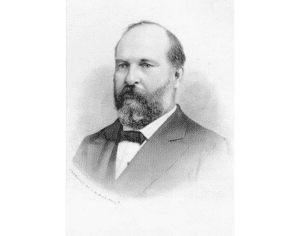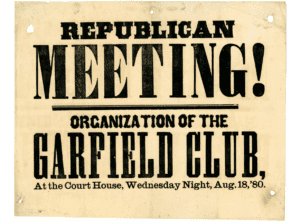Presenting facts from a particular point of view is often at the heart of political disagreements. Getting voters to agree with your candidate’s view is essential to winning elections. Political parties try to spin a story or situation to their best advantage. This political cartoon from the collections of the Ohio History Connection shows that this was as true in 1880 as it is today. The symbols included in the cartoon would have been clearly understood by the people of the time. For us, their meaning requires some explanation.
James A. Garfield of Ohio was the Republican candidate for president in 1880. Garfield had been serving in the U.S. House of Representatives since the Civil War. One of Garfield’s actions while serving in Congress became an issue during the presidential campaign.

Reproduction of an engraved portrait of President James A. Garfield. J.R. Rice (Engraver) 1880’s Ohio History Connection
The completion of the transcontinental railroad in 1869 was a tremendous achievement that was quite expensive. Private firms like the Credit Mobilier Company raised funds for the Union Pacific Railroad and lobbied Congress to support their efforts. The Railroad and the Company worked together to overcharge the government to complete the project, making huge profits at the public’s expense. Critics blamed congressmen like Garfield for being complicit or incompetent. During the process, Garfield took $329 from the Credit Mobilier Company. He claimed it as a loan that he later repaid. Political opponents saw it as a bribe.
Years later, during the presidential campaign, the issue came to light again. Republicans promoted Garfield as a war hero who’s personal and public life were both honest and honorable. Democrats saw the Credit Mobilier scandal as a blot on Garfield’s character. At the very least, his actions showed poor judgement. Republicans responded that Democrats were slandering an innocent man.

This broadside was published to advertise a meeting of the organization of the Garfield Club in Dayton, Ohio, on August 18, 1880, a gathering of influential Republican party supporters and members. Ohio History Connection
In 1880, there were no national public opinion polls to inform the political parties as to how their candidates were doing. However, there were local elections held in September in Maine and in October in Ohio and Indiana. How the political parties performed in these local elections tended to predict how they would do in the national election in November. In September, Democrats did well in Maine. Their campaign to besmirch Garfield’s reputation had succeeded. By October, Republicans had spun the issue to their advantage, doing well in both Ohio and Indiana.
Garfield would go on to win election for president in November. This lithograph made by Currier & Ives after the campaign was over, would have been popular with pro-Garfield supporters.